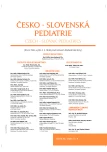Growth disorder in 11-year-old girl with diabetes
Authors:
R. Pomahačová 1; T. Pomahačová 2; K. Fiklík 1; P. Paterová 1; J. Sýkora 1
Authors‘ workplace:
Dětská klinika FN Plzeň, Univerzita Karlova v Praze, Lékařská fakulta v Plzni
1; Neonatologické oddělení FN a LF UK Plzeň
2
Published in:
Čes-slov Pediat 2020; 75 (4): 256-261.
Category:
Overview
Pituitary stalk interruption syndrome (PSIS) is one of the causes of congenital hypopituitarism. It is based on a genetically-linked disorder of pituitary morphogenesis. Typical findings on magnetic resonance imaging (MRI) of the brain are hypoplasia or aplasia of anterior pituitary lobe, ectopic posterior pituitary lobe, and absent or thin pituitary stalk. A rare cause of acquired hypopituitarism in children may be autoimmune hypophysitis.
We present a case of an 11-year-old girl with simultaneously diagnosed combined pituitary growth hormone deficiency, central hypothyroidism, central hypocorticalism and the initial phase of diabetes mellitus type 1 (DM). The diagnosis of hypopituitarism was based on a growth disorder with progressive growth retardation from the age of 7 years. In the differential diagnosis, autoimmune hypophysitis was primarily considered, but the brain MRI finding suggested PSIS. The deficiency of cortisol and growth hormone affected the manifestation of DM and the initial need for insulin before initiating hydrocortisone and growth hormone replacement therapy.
Keywords:
growth disorder – hypopituitarism – pituitary stalk interruption syndrome – diabetes mellitus type 1 – autoimmune hypophysitis
Sources
1. Lebl J, Krásničanová H. Růst dětí a jeho poruchy. Praha: Galén, 1996.
2. Lebl J, Al Taji E, Koloušková S, et al. Dětská endokrinologie a diabetologie. Praha: Galén, 2016.
3. Pomahačová R, Kalvachová B. Dětská endokrinologie do kapsy. Praha: Mladá fronta, 2013.
4. Bar C, Zadro C, Diene G, et al. Pituitary stalk interruption syndrome from infancy to adulthood: Clinical, hormonal and radiological assessment according to the initial presentation. PLoS One 2015; 10 (11): e0142354. doi: 10.1371/journal.pone.0142354.
5. Fujisawa I, Kikuchi K, Nishimura K, et al. Transection of the pituitary stalk: development of an ectopic posterior lobe assessed with MR imaging. Radiology 1987; 165 (2): 487–489. PMID: 3659371.
6. Reynaud R, Albarel F, Saveanu A, et al. Pituitary stalk interruption syndrome in 83 patients: novel HESX1 mutation and severe hormonal prognosis in malformative forms. Eur J Endocrinol 2011; 164 (4): 457–465. doi: 10.1530/EJE-10-0892. PMID: 21270112.
7. Melo ME, Marui S, Carvalho LR, et al. Hormonal, pituitary magnetic resonance, LHX4 and HESX1 evaluation in patients with hypopituitarism and ectopic posterior pituitary lobe. Clin Endocrinol (Oxf) 2007; 66 (1): 95–102.
8. Pinto G, Netchine I, Sobrier ML, et al. Pituitary stalk interruption syndrome: a clinical-biological-genetic assessment of its pathogenesis. J Clin Endocrinol Metab 1997; 82 (10): 3450–3454. PMID: 9329385.
9. Tauber M, Chevrel J, Diene G, et al. Long-term evolution of endocrine disorders and effect of GH therapy in 35 patients with pituitary stalk interruption syndrome. Horm Res 2005; 64 (6): 266–73. PMID: 16260897.
10. Guo Q, Yang Y, Mu Y, et al. Pituitary stalk interruption syndrome in Chinese people: clinical characteristic analysis of 55 cases. PLoS One 2013; 8 (1): e53579. PMID: 23341953. doi: 10.1371/journal.pone.0053579.
11. Romano A, Rigante D, Cipolla C. Autoimmune phenomena involving the pituitary gland in children: New developing data about diagnosis and treatment. Autoimmun Rev 2019; 18 (10): 102363.
12. Kalra AA, Riel-Romero RM, Gonzalez-Toledo E. Lymphocytic hypophysitis in children: A novel presentation and literature review. J Child Neurol 2011; 26 (1): 87–94.
13. Molitch ME, Gillam M. Lymphocytic hypophysitis. Horm Res 2007; 68 (5): 145–150.
14. Rivera JA. Lymphocytic hypophysitis: disease spectrum and approach to diagnosis and therapy. Pituitary 2006; 9 : 35–45.
15. Kalra AA, Riel-Romero RM, Gonzalez-Toledo E. Lymphocytic hypophysitis in children: A novel presentation and literature review. J Child Neurol 2011; 26 (1): 87–94.
16. Lupi I, Broman KW, Tzou SC, et al. Novel autoantigens in autoimmune hypophysitis. Clin Endocrinol 2008; 69 : 269–278.
17. Falorni A, Minarelli V, Bartoloni E, et al. Diagnosis and classification of autoimmune hypophysitis. Autoimmun Rev 2014; 13 : 412–6.
Labels
Neonatology Paediatrics General practitioner for children and adolescentsArticle was published in
Czech-Slovak Pediatrics

2020 Issue 4
- What Effect Can Be Expected from Limosilactobacillus reuteri in Mucositis and Peri-Implantitis?
- The Importance of Limosilactobacillus reuteri in Administration to Diabetics with Gingivitis
Most read in this issue
- Noonan syndrome and other RASopathies: Aetiology, diagnostic procedures and therapy
- Etiology and diagnostic approach of growth failure in children born small for gestational age (SGA) with persistent short stature in childhood (SGA-SS)
- Noonan syndrome from a paediatric cardiologistˇs perspective
- Prenatal phenotype of RASopathies
